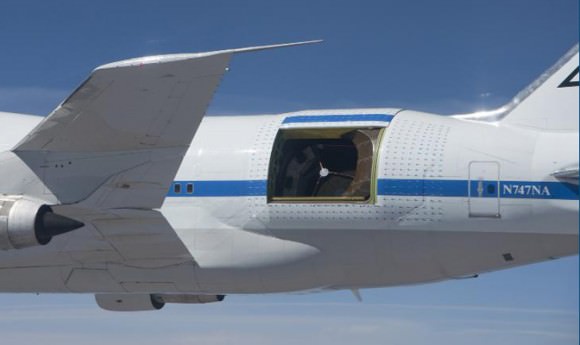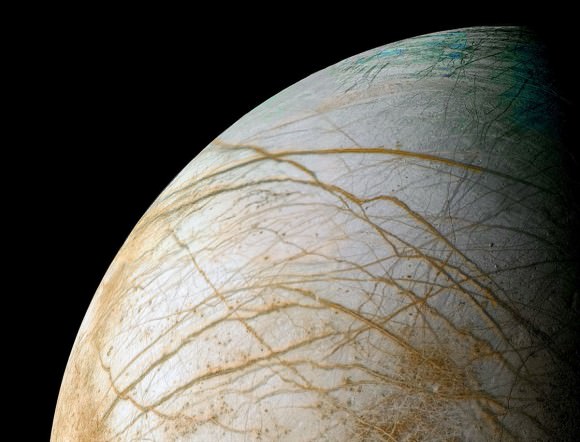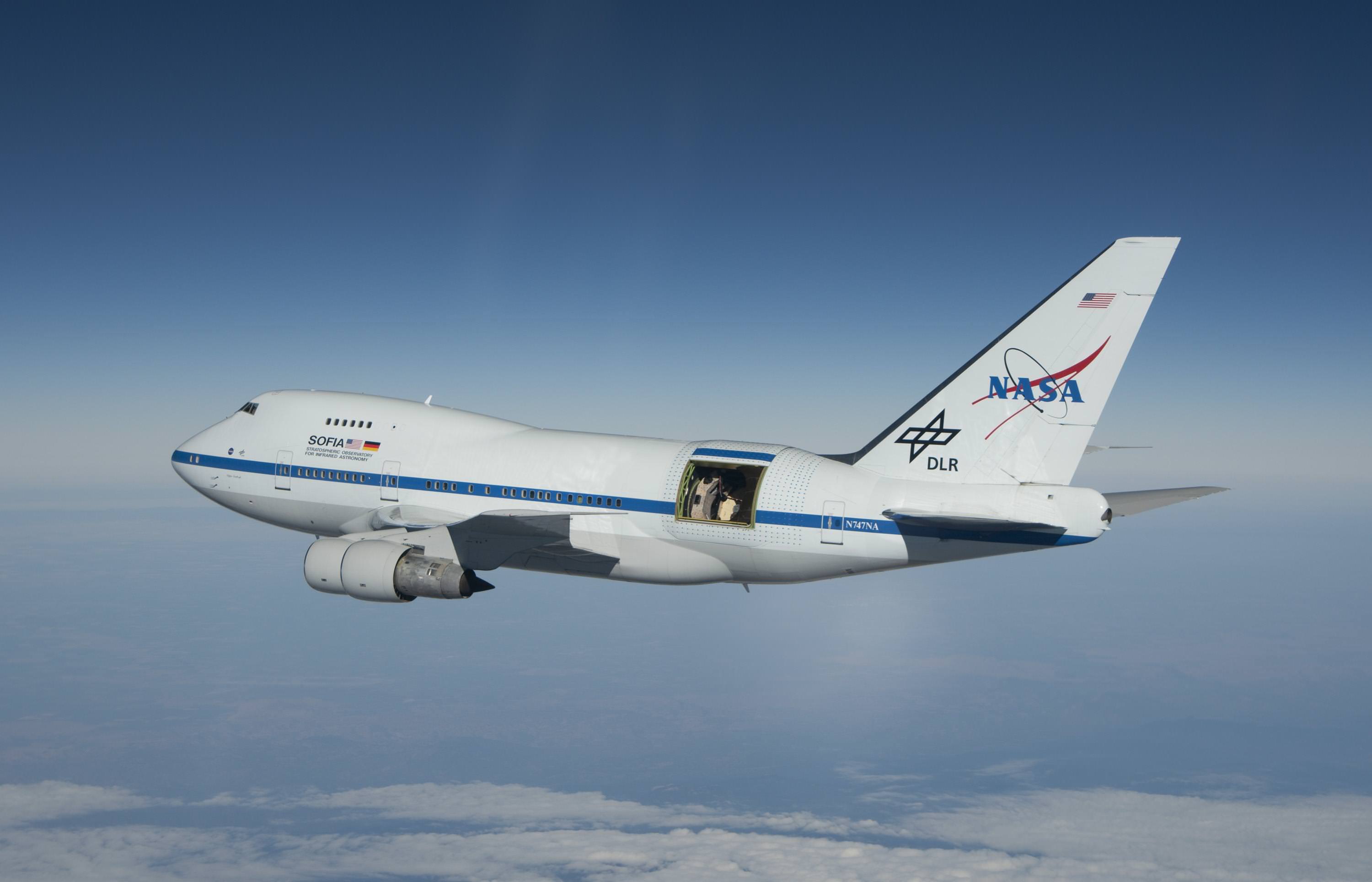NASA is prepared to axe an airborne telescope to keep “higher-priority” programs such as the Saturn Cassini mission going, according to budget documents the agency released today (March 4). We have more information about the budget below the jump, including the rationale for why NASA is looking to shelve its Stratospheric Observatory for Infrared Astronomy (SOFIA).
NASA’s has been flying the telescope for just over three years and recently took some nice snapsnots of the M82 supernova that astronomers have been eager to image. The agency’s administrator, however, said SOFIA has had its shot and it’s time to reallocate the money for other programs.
“SOFIA has earned its way, and it has done very well, but we had to make a choice,” said NASA administrator Charlie Bolden in a conference call with reporters regarding the fiscal 2015 $17.46 billion budget request. He added that NASA is in discussions with partner DLR (the German space agency) to look at alternatives, but pending an agreement, the agency will shelve the telescope in 2015.
In a short news conference focusing on the telescope only, NASA said the observatory had been slated to run for another 20 years, at a cost of about $85 million on NASA’s end per year. (That adds up to $1.7 billion in that timeframe by straight math, but bear in mind the detailed budget estimates are not up yet, making that figure a guess on Universe Today’s part.) DLR funds about 25% of the telescope’s operating budget, and NASA the rest.

“SOFIA does have a rather large operating cost compared to other missions, second only to Hubble [Space Telescope],” said NASA chief financial officer Beth Robinson in the second conference call. “There is a distinct trade in the operating mission universe about how many keep going and how much you free up (for new missions).”
The telescope isn’t the only such “trade” NASA made, Robinson added. Although not an exhaustive list, she said funding for the Orbiting Carbon Observatory 3 (OCO-3) is not in the base budget request, nor funding to accelerate development of the Pre-Aerosol, Clouds and ocean Ecosystem (PACE) mission.
SOFIA examines a “unique” part of the infrared spectrum, added NASA’s Paul Hertz, who heads the astrophysics division, but he noted infrared science is also performed by the Spitzer Space Telescope and the European Southern Observatory’s Atacama Large Millimeter Array. Coming up soon is the James Webb Space Telescope. Also, the budget allocates development money for a new infrared observatory called Wide-Field Infrared Survey Telescope (WFIRST).
Below are other notable parts of the 2015 budget. These are high-level statements missing some detail, as the rest of NASA’s documentation won’t be released publicly until late this week or early next.

– NASA’s budget falls overall to $17.46 billion, down one percent from $17.64 billion. Planetary science and human exploration each had nearly equal reductions of around three percent, with education taking the deepest cut (24%) in high-level categories as NASA moves to consolidate that directorate with other agencies.
– Funding continues for 14 operating planetary missions, which are presumably the same 14 missions that are contained here. (That list includes Cassini, Dawn, Epoxi, GRAIL, Juno, Lunar Reconnaissance Orbiter, Mars Exploration Rover/Opportunity, Mars Express, Mars Odyssey, Mars Reconnaissance Orbiter, Mars Science Laboratory/Curiosity, MESSENGER, New Horizons and Rosetta.) Separately, James Webb Space Telescope funding stays about the same as fiscal 2014, keeping it on track for a 2018 launch.
– NASA plans a mission to Europa. This was identified as the “second highest priority Flagship mission for the decade” in the National Research Council planetary science decadal survey, which called for a mission for “characterization of Europa’s ocean and interior, ice shell, chemistry and composition, and the geology of prospective landing sites.” NASA has allocated $15 million in fiscal 2015 for this mission, but it’s unclear if it’s going to be a big mission or a small one as the agency is still talking with the science community (and presumably checking its budget, although officials didn’t say that). If this goes through, it would fly in the 2020s.

– NASA’s humans-to-asteroid mission gets some more money. The agency requests $133 million for goals including “advancing solar electric propulsion and capture systems, and conduct of the Mission Concept Review in which the mission architecture will be established.” During the conference call with reporters, Bolden said the asteroid capture mission is a key step for NASA’s aim to have a manned Mars mission in the 2030s.
– Funding continues for NASA’s commercial crew program and Orion/Space Launch System program. It remains to be seen if the amounts allocated will be enough for what industry insiders hope for, but on a numbers basis, the Orion/SLS infrastructure funding falls to $2.78 billion (down 12% from $3.115 billion in FY 2014) and commercial crew funding increases to $848.3 million (up 20% from $696 million in FY 2014). Note the 2014 numbers are not finalized yet. NASA says the commercial funding will allow the program to maintain “competition”, although details are under wraps as the agency is evaluating proposals.
– The International Space Station is extended to 2024. That news was made public in early January, but technically speaking that is a part of the fiscal 2015 budget.
There’s far more to the budget that could be covered in a single news article, and it should be noted there was an entire aviation component as well. We encourage you to check out the budget documents below for the full story so far.
– 2015 budget overall fact sheet
– 2015 budget category fact sheets (science, aeronautics research, space technology, etc.)


Stories like this burn my toast! Am thinking about wasted opportunities and bureaucratic boondoggle.
I wonder if the DLR would be interested in purchasing a used 747 and included high tech telescope? After all the DLR and NASA spent something like $1.25 billion building SOPHIA…. you’d think the reasoning for building it would still be valid? i.e. The ‘mission of opportunity’ value of this asset is undeniable.
oTay then… what if we ‘lend leased’ it to them? Or maybe it’s ownership and use could be worked it out in a trade deal? Here’s hoping they step up to the plate and propose a reasonable solution… which has gone missing in this country~
SOPHIA brings up this thought. What if every jet liner had a miniature automated telescope incorporated into it’s airframe? Kind of like a Russian ‘dash cam’ but with multiple views? WHAT would these cameras see at night? or during the day? Daylight meteors? Fireballs? Gamma Ray bursts? Compton rad showers? Sprites? Fairies? Jellyfish? Imagine instrumenting every commercial aircraft… any ETI evidence out thar? We’d do that… in a purrfect whirled anyway! ~@; )
That was my initial reaction as well, but actually it’s a little under-informed. Keep in mind that Sofia was 14 years in development, and that the system runs on Solaris equipment with equally old software. Add the availability of other systems that see the same spectrum (although it is true that demand is high), and you have a fairly easy decision, even though it is a helluva achievement.
IMO the aircraft is perhaps the most interesting part…it’s one of <50 very interesting 747 variants originally designed for NY-Mideast or South Africa to London routes.
Budget revelations like this underscore why it’s never too late to cancel SLS – the giant rocket to nowhere (ie, once this rocket has been built there would be no funds left to go anywhere or do anything as confirmed by numerous reports and independent consultants).. After cancellation, task SpaceX, Boeing, Orbital Sciences, Sierra Nevada and other COTS contenders with servicing the launch market and allocate the remaining funds to the really important and ground-breaking science missions (like the ones listed above).
My 2c (which has been reiterated countless times over the last decade along with others who see this pork barrel budget madness for what it is) Congress should not be in the rocket design business (NASA is being forced by congress to build an interplanetary rocket – Senators & Representatives are not rocket scientists).
On target. If SLS (Senate Launch System, district pork barrel for re-election votes) ever flies, which I seriously doubt, it will only fly once every several years because each launch is projected to cost billions. Billions. This is insanity. Just to refresh memories, NASA’s X-33 never flew. A hangar queen the effort ran into technical problems and was abandoned.
COTS. Save the $ and spend on space science missions.
This is sad and outrageous. A billion $ “aid” for Ukraine is available within hours, human rated missions to a 10m asteroid are being “sold” to the general public as a great goal for our science and exploration, and then they decide to cancel a relatively new, perfectly working instrument and say “we don’t have the money”?
It kind of reminds me of abrupt self destruction of the China’s Navy in the 15th century commanded by Zheng He. At the time, it was the most powerful navy in the world. Its self destruction was followed by self isolation of China and, further on, to its colonization by the West.
Argumenting the cancellation with plans for JWST is like saying “who needs a working telescope if we are going to have one in 5 years?” as if it had never made any sense to have more than one instrument of a kind. Besides, JWST isn’t ready yet and won’t be for years.
To be clear, I have nothing against Ukraine and I wish her all the best. This comment is about US and NASA, not Ukraine.
Sofia would cost well over a billion dollars to keep operating over its projected lifetime (747s are incredibly expensive machines). They could build a larger infrared space telescope that would observe the same part of the spectrum… and run it for just as long as Sofia for less money than that (400 million in construction, 100m in launch costs, and 25 million a year in operating budget for 20 years).
So if it came down to it, which would you prefer? An on-again-off-again plane based scope that flies once in a blue moon, or a cheaper, larger, more capable space based infrared telescope?
I’d say the choice is clear. Sofia was doomed from the start. It was a bad idea and should have been cancelled long ago.
PS, Sofia would cost a total of about 2 and a quarter billion dollars to develop, build, and operate over its 20 year lifetime, if you add up sunk development costs and projected operating costs. We could have even had another flagship space telescope like Hubble for less than that.
gopher65, I’d say let’s use both SOFIA and the Space Telescope! I’d cancel some weapons instead. Of course, I’m not a politician but a hobby astronomer. And this site is about astronomy and (most of the time, at least) not about politics. Sometimes, however, it seems that politics just can’t be avoided. It would be great to see efforts to promote STEM (science, technology, and math) bear fruits and I think shelving SOFIA is doing the opposite. For a time, something similar was threatening JWST, but after enough people raised their voices to keep JWST alive, it was saved. The current plans for SOFIA show that even JWST may one day be developed and launched, only to get mothballed afterwards to “save money”. I’d invite anyone with the same impression to let their political representative know what they think about saving money by cancelling the wrong thing.
Sad news. Just a few days ago we had a story here on Universe Today about this instrument doing some wonderful observations of a supernova.